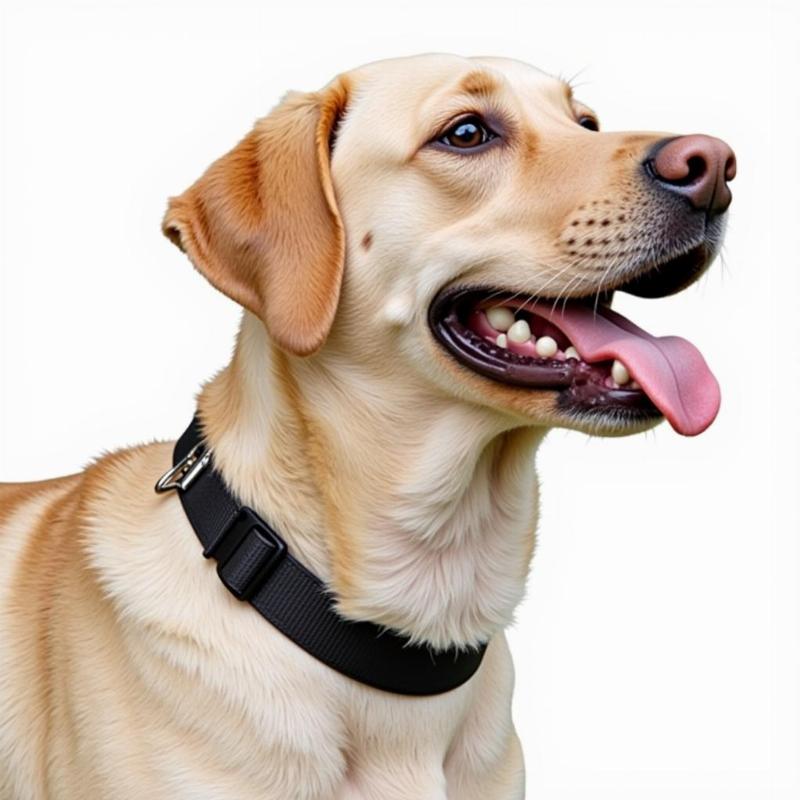Nylon slip collars, also known as slip leads, are a common dog collar choice in the US. They offer convenience and adjustability, making them popular for training, walking, and even quick trips to the vet. But are they the right choice for your dog? This comprehensive guide will explore the pros and cons of nylon slip collars, how to use them correctly, and alternative options to consider.
Understanding Nylon Slip Collars
Slip collars are essentially a loop of material, traditionally nylon, that tightens around a dog’s neck when pulled. This tightening action provides a correction and discourages pulling. While they can be effective training tools, improper use can lead to choking, tracheal damage, and even neurological problems.  Dog Wearing a Nylon Slip Collar
Dog Wearing a Nylon Slip Collar
How Slip Collars Work
The design of a slip collar relies on pressure and release. When a dog pulls, the collar tightens, creating discomfort. When the dog stops pulling, the pressure releases, providing negative reinforcement. This teaches the dog to associate pulling with an unpleasant sensation and loose leash walking with comfort.
Potential Risks of Using Slip Collars
While slip collars can be useful, it’s crucial to understand the potential risks. Used incorrectly, they can cause serious harm. Choking is a significant concern, especially for brachycephalic breeds (dogs with short noses like Bulldogs or Pugs). Long-term use can also damage the trachea and other sensitive structures in the neck. Some studies even suggest a link between slip collar use and neurological problems.
Choosing the Right Nylon Slip Collar
Not all nylon slip collars are created equal. Consider the following factors when selecting one for your dog:
- Material: Opt for high-quality, durable nylon that is resistant to fraying and wear.
- Width: Choose a width appropriate for your dog’s size and breed. Thicker collars distribute pressure more evenly.
- Hardware: Check for sturdy metal rings that can withstand regular use.
Proper Usage of Nylon Slip Collars
Proper usage is paramount for preventing injury and ensuring the collar’s effectiveness.
Positioning the Collar
The collar should sit high on the dog’s neck, just behind the ears. Positioning it too low can put pressure on the trachea and esophagus. harness for deep chested dogs
Training Techniques
Use short, gentle corrections with the slip collar. Constant pressure or jerking can be harmful. Combine the collar with positive reinforcement techniques, like rewarding your dog for loose leash walking. life is good dog collar
“Slip collars can be effective when used correctly, but they’re not a one-size-fits-all solution,” says Dr. Emily Carter, a certified veterinary behaviorist based in Chicago. “It’s crucial to understand the potential risks and prioritize your dog’s safety and well-being.”
Alternatives to Nylon Slip Collars
Several alternatives offer similar control without the same risks as slip collars.
- Martingale Collars: These collars offer a limited slip action, preventing choking while still providing gentle correction.
- Harnesses: Harnesses distribute pressure across the chest and shoulders, making them a safer and more comfortable option for many dogs. dog collars with 2 d rings
- Head Halters: Head halters gently redirect the dog’s head, making them effective for managing pulling. san francisco giants dog collar
Conclusion
Nylon slip collars can be a useful tool for training and managing dogs, but they come with potential risks. Understanding how to use them correctly and considering the alternatives is crucial for responsible dog ownership. Prioritizing your dog’s comfort and safety should always be the top priority when choosing a collar.
FAQ
- Are nylon slip collars safe for puppies? Generally, it’s best to avoid slip collars on puppies due to their delicate necks.
- Can I leave a slip collar on my dog all the time? No, slip collars should only be used for training and walking, never left on unsupervised.
- What if my dog continues to pull even with a slip collar? Consult a certified dog trainer or veterinary behaviorist for personalized guidance.
- Are there any breeds that shouldn’t wear slip collars? Brachycephalic breeds and dogs with neck injuries should avoid slip collars.
- What’s the difference between a slip collar and a martingale collar? Martingale collars offer limited slip, preventing choking while still providing control.
- How do I choose the right size slip collar for my dog? Measure your dog’s neck circumference and choose a collar that is slightly larger.
- What are some signs that a slip collar is too tight? Coughing, gagging, and difficulty breathing are signs that the collar is too tight.
Beautdogs.us is your premier source for all things dog-related in the US. We offer expert advice on dog breeds, care, and products, catering to both new and experienced dog owners. We pride ourselves on providing reliable and engaging content to help you navigate the joys and challenges of dog ownership. For personalized advice or to explore our wide range of dog products, contact us at [email protected] or call us at +1 501-555-7529. Beautdogs.us is your trusted companion on your dog ownership journey.